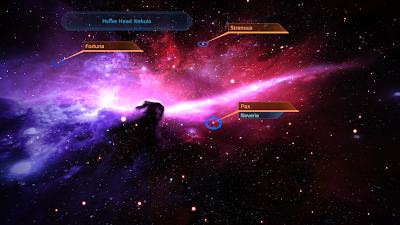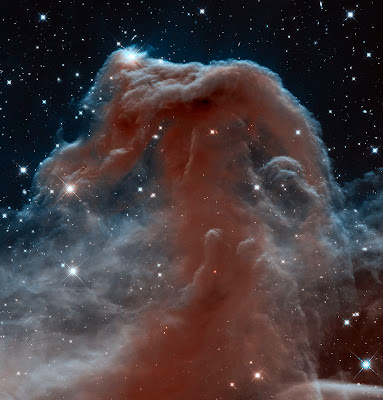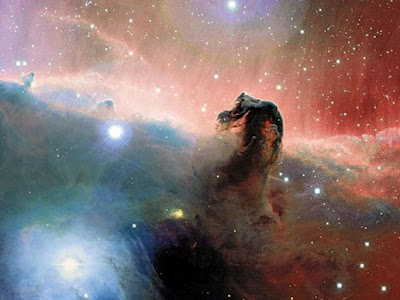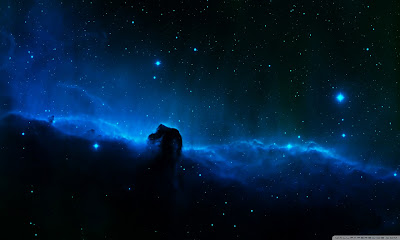The Horse Head Nebula (also known as Barnard 33 in bright nebula IC 434) takes its name from the horse head shape in its middle. The first human to discover it was Williamina Fleming in 1888 at Harvard University. It is one of the most identifiable nebulae because of the shape of its swirling cloud of dark dust and gases, which bears some semblance to a horse's head when viewed from Earth.
The Horsehead Nebula is a dark nebula in the constellation Orion. The nebula is located just to the south of the star Alnitak, which is farthest east on Orion's Belt, and is part of the much larger Orion Molecular Cloud Complex.
The red glow originates from hydrogen gas predominantly (Mainly) behind the nebula, ionized by the nearby bright star Sigma Orionis. The darkness of the Horsehead is caused mostly by thick dust, although the lower part of the Horsehead's neck casts a shadow to the left. Streams of gas leaving the nebula are funneled by a strong magnetic field. Bright spots in the Horsehead Nebula's base are young stars just in the process of forming.
The nebula is a favorite target for amateur and professional astronomers. It is shadowy in optical light. It appears transparent and ethereal when seen at infrared wavelengths. The rich tapestry of the Horsehead Nebula pops out against the backdrop of Milky Way stars and distant galaxies that easily are visible in infrared light.
The nebula is part of the Orion Molecular Cloud, located about 1,500 light-years away in the constellation Orion. The cloud also contains other well-known objects such as the Great Orion Nebula (M42), the Flame Nebula, and Barnard's Loop. It is one of the nearest and most easily photographed regions in which massive stars are being formed.
The Horsehead Nebula is a dark nebula in the constellation Orion. The nebula is located just to the south of the star Alnitak, which is farthest east on Orion's Belt, and is part of the much larger Orion Molecular Cloud Complex.
- Constellation: Orion
- Distance to Earth:1,500 light-years
The red glow originates from hydrogen gas predominantly (Mainly) behind the nebula, ionized by the nearby bright star Sigma Orionis. The darkness of the Horsehead is caused mostly by thick dust, although the lower part of the Horsehead's neck casts a shadow to the left. Streams of gas leaving the nebula are funneled by a strong magnetic field. Bright spots in the Horsehead Nebula's base are young stars just in the process of forming.
The nebula is a favorite target for amateur and professional astronomers. It is shadowy in optical light. It appears transparent and ethereal when seen at infrared wavelengths. The rich tapestry of the Horsehead Nebula pops out against the backdrop of Milky Way stars and distant galaxies that easily are visible in infrared light.
The nebula is part of the Orion Molecular Cloud, located about 1,500 light-years away in the constellation Orion. The cloud also contains other well-known objects such as the Great Orion Nebula (M42), the Flame Nebula, and Barnard's Loop. It is one of the nearest and most easily photographed regions in which massive stars are being formed.









0 comments:
Post a Comment
IT'S YOUR TURN...
To respond : Drop in just anything but spam. Please don't drop comments just to add your link here. You can use basic HTML tags.
Important : If you're looking for further clarification, advice or support, please address by comment.